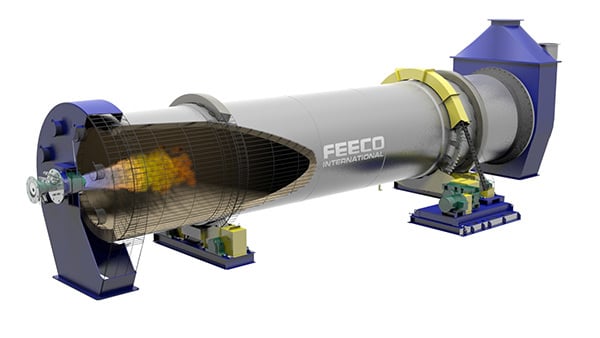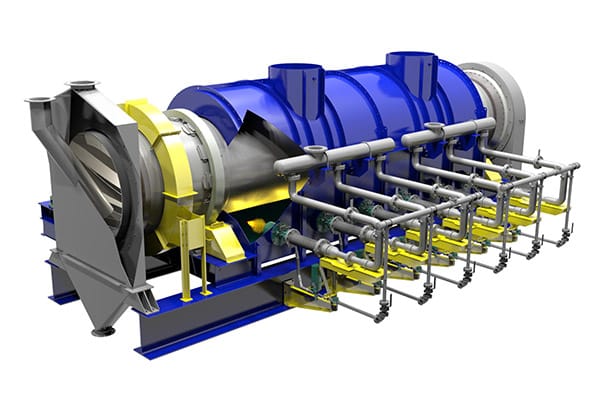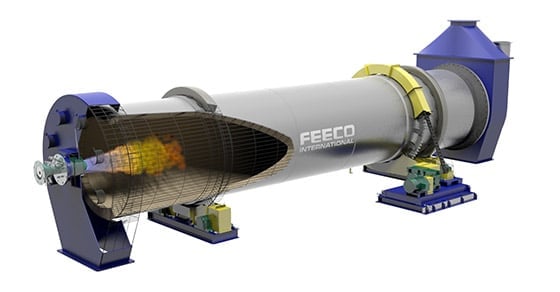Industrial pigments play an important role in the performance and durability of many products. In addition to serving as a coloring agent, pigments can also offer protection against corrosion and even UV rays; pigments are all around us, from building materials and concrete, to textiles, papers, printing inks, artists’ paints, and more.
An increasing demand for specialty products, combined with prolific use in plastics, paints, coatings, and other applications has experts estimating that the pigment market will see a CAGR of 4.5% between 2016 and 2024.
While there are many potential avenues used to produce pigments, many of these processes have one piece of equipment in common: the rotary kiln. Rotary kilns play an integral role in producing many of the high quality pigments industries rely on today.
How Rotary Kilns are Used in Pigment Production
As mentioned, there are a number of different ways to produce industrial pigments, often even within each category of pigments.
Rotary kilns are a high temperature thermal processing device used throughout many of these processes to cause a physical change or chemical reaction in the material in order to impart the intended pigment properties. They are often used to carry out the diverse objectives pigment producers require, such as thermal decomposition, oxidation, calcination, reduction, and more.

Image: 3D Model of a Direct-Fired FEECO Rotary Kiln
Processing conditions can have a significant impact on the properties of the pigment and must be carefully controlled to achieve the desired results. This careful control is one of the advantages of the rotary kiln, which can be engineered to create the exact processing atmosphere and conditions required to influence pigment properties such as color, particle size, and even tinting strength. Typical customized design considerations include:
- Direct- or Indirect-fired
- Air flow (co-current or counter current)
- Temperature profiles
- Residence Times
- Bed disturbers and dams
- And more….

Image: 3D Model of an Indirect-Fired FEECO Rotary KilnSome of the most common ways in which the rotary kiln is used in pigment production are described below.
Titanium Dioxide (TiO2)
Titanium dioxide (TiO2) is the most commonly used material for creating white pigments. In producing TiO2 pigments, the rotary kiln is critical to carrying out one of two primary methods of production: The Sulfate Process.
The Sulfate Process
The Sulfate Process is typically used for lower grade ores. In this process, the titanium ore goes through various steps in order to extract the titanium dioxide and produce it in a hydrated form that can be calcined.
Once this hydrated TiO2 is formed, a calciner, or rotary kiln is employed to produce the titanium dioxide in an anhydrous form.
Zinc Oxide (ZnO)
Zinc oxide is another white pigment commonly used in paper coatings, printing inks, and artists’ media.
There are three primary methods of producing zinc oxide pigment, two of which, rely on the rotary kiln:
The Direct Process (aka., The American Process)
The Direct Process of producing zinc oxide pigments is favored for its simplicity, cost effectiveness, and energy efficiency.
The direct process relies first on reducing a zinc-containing raw material or metal. This is carried out in a rotary kiln at high temperatures with coal as the reducing agent. Once the material is reduced to zinc, the metal vapor can be oxidized to produce zinc oxide.
Further calcination or other thermal treatment may be desirable to improve or fine-tune pigment properties.
Indirect Process (aka., The French Process)
There are a few variations on the indirect process, which involves the melting and vaporization of zinc-containing metals, followed by oxidative combustion. In one variation on this process, the rotary kiln is used to carry out these objectives. The advantage in this setting is that the heat of combustion can be utilized elsewhere in the plant.
Lithopone Pigments
Lithopone is another type of white pigment. This type of pigment is comprised of zinc sulfide and barium sulfate.
The rotary kiln is employed twice in the creation of lithopone pigments:
Barium Sulfate Production: Barium sulfate is created by reacting barite with petroleum coke in a rotary kiln.
Calcination of Filter Cake: Barium sulfate and zinc salt are mixed to create a uniform solution. Crystallites of “raw lithopone” are formed and the resulting filter cake is calcined in a direct-fired rotary kiln. Upon calcination, the mixture goes through a number of additional steps including quenching, classification and separation, thickening, filtering, washing, drying, and grinding in order to produce a suitable pigment.
Iron oxides
Iron oxides provide a diverse range of earth tone hues to the pigment industry. In the production of iron oxide pigments (IOPs), rotary kilns can be used to carry out a variety of different objectives.
The rotary kiln is used in the production of IOPs in the Laux process, and can also be used after any of the three main IOP production methods in order to carry out calcination on the pigments to produce a variation of red hues.
Pigment Process & Product Development through Testing
With so many variables, testing such as that carried out in the FEECO Innovation Center is often a critical aspect in developing a specific pigment product and the process to create that product.
Testing is first carried out at batch scale to gather initial process data and define the parameters that will produce the desired product. This may include any number of factors, but generally includes gathering data on residence time, temperature profile, airflow, and more. Samples may also be produced for field testing needs.
The data gathered during batch testing can then be used in continuous, pilot-scale testing trials to develop the data necessary for process scale-up. Various test kilns are available in the FEECO Innovation Center to accommodate all pigment testing possibilities. Our thermal testing capabilities are also complemented by our agglomeration (particle size enlargement) testing services and system expertise.
Conclusion
The examples listed here represent just a few of the methods in which the rotary kiln provides a key processing medium to produce an ideal pigment product. The customizability of the rotary kiln to carry out various objectives makes the rotary kiln an ideal process setting for both the production and enhancement of many types of pigments. To find the ideal process solution, testing at batch and pilot scale are often a necessity.
In addition to our thermal testing capabilities offered in the Innovation Center, FEECO provides custom rotary kilns and calciners for all of your pigment processing needs. Our highly engineered systems are designed around your exact specifications and requirements to provide optimal processing. In addition to our rotary kilns, we also offer a variety of agglomeration equipment for improving the handling qualities of pigments, as well as a wide range of material handling equipment. For more information on our pigment processing capabilities, contact us today!

